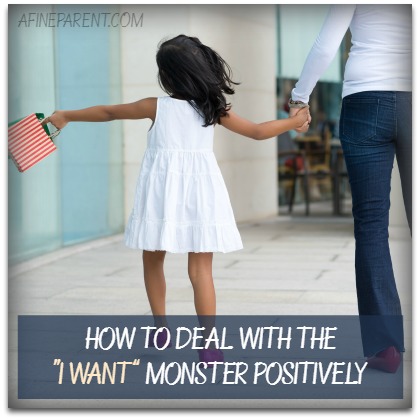 I hate shopping with my children.
I hate shopping with my children.
There. I said it. And I’ll say it again.
I hate shopping with my children.
There is nothing I dread more than taking my kids into a store. Any store. Grocery. Clothing. Toys. Especially toys.
It’s not that they are bad children. They are well-behaved for the most part. But at some point, as we are wandering around the store, the “I WANT” Monster appears.
The “I WANT” Monster is a wild little Tasmanian devil. He comes whirling and spinning out of his cave at the first scent of anything bright and shiny and new.
“I want this.”
“Can I have that?”
“I need these.”
“Please, please buy me those.”
Everything around them is a candy-colored rainbow. It’s sooooo tempting.
“I just can’t stand it!” panted my 7-year-old son, standing in the Star Wars aisle of Target, tortured by the clones and Jedi surrounding him.
Me either, son.
What’s with all this greed? Where does the “I WANT” Monster come from anyway?
Every child wants things. Heck, we all want things. Just today I was tempted by a really pretty China bowl with metal hummingbird on the rim and a hot pair of heels that would look perfect with a dress I have.
In a world of television and social media overload, our society has pushed “keeping up with the Jones’s” to a whole new level. It’s hard to curb materialistic desires, but here are 5 techniques that can help.
1. Find Other Joys
 You know why we love buying things? Why our children feel total elation over getting yet another Lego set? It turns out it’s a chemical in our brains called dopamine.
You know why we love buying things? Why our children feel total elation over getting yet another Lego set? It turns out it’s a chemical in our brains called dopamine.
A Wall Street Journal interview with Gregory Burns, a neuroscientist with Emory University says, “Dopamine is associated with feelings of pleasure and satisfaction, and it’s released when we experience something new, exciting, or challenging. And for many people, shopping is all those things.”
Luckily, there is another way to get this dose of dopamine. Physical activity. Ever heard of the runner’s high? That is due to dopamine.
In fact, anything that is hard work or a thrill will get you that same feeling. So instead of having your child focus on things, get them focused on other joys. Take them hiking. Challenge them with a new building project.
When you teach them a new way of getting that same dopamine high, they will go back to that activity instead of needing to buy more things to feel good.
2. Instill the Joy of Giving
We all know the phrase, “’tis better to give than to receive.” It’s true for me. I feel better when I give a gift than when I get a gift.
Focusing on what they will be giving to others helps to distract my boys from the getting. It also teaches kids to put others first and instills empathy for others.
Growing up, our church had a giving tree at Christmas. It was hung with paper ornaments with a child’s age and a list of needs and wishes. My brother and I would each choose an ornament and then go shopping for gifts for them. We never knew their names. We never saw them receive the gifts. But we knew the generosity we were showing was making a positive difference in their lives.
I continue to do this as an adult. And not just at Christmas. When I bake, I will often have the boys put together a plate of goodies for our neighbors. I also have them use their artistic talents. They use paint and colors to make birthday and get-well cards for their friends and grandparents.
We talk about how special it is that we made it ourselves. We chat about how good we feel to share something with others. Helping them to practice generosity through sharing their talents not only increases their ability to empathize with others, but it also builds their self-esteem by validating their talents.
3. Encourage Gratitude
 Along with generosity goes gratitude. Thankfulness for the gifts we have received in our lives.
Along with generosity goes gratitude. Thankfulness for the gifts we have received in our lives.
By gifts I don’t only mean presents. I’m talking about feeling gratitude for the school supplies we just purchased, the clean clothes in the closet, or the time I give them on the iPads.
There are many ways one can try to help gratitude bubble up from the subconscious to the conscious. If I want them to appreciate clean clothes or dinner on the table, I need to have them help me with the laundry and cooking. Once they put in the effort, they will appreciate what it takes for all this to happen around them.
Another way to get them to feel some gratitude is to actually ask them what they feel grateful for. A study by the University of Illinois found that when kids, ages 11-17, kept a gratitude journal there was a significant increase in gratitude and a decrease in materialism. In just 2 weeks.
My kids are reluctant to journal and won’t do it consistently, so we started a gratitude moment at the dinner table instead. My husband and I ask the boys what they feel grateful for today and we share our own thoughts. It makes for a nice, warm family moment.
It can be anything from “we got dessert today” and to “that I have you for a mom and dad.” The point is you get them thinking about all the good things they already have in their lives. After a while they end up “I WANT”ing less.
4. Slow Down and Find Mindfulness
A partner of generosity and gratitude is mindfulness. Mindfulness is being really aware and conscious of actions you take, how you feel, and what is happening around you.
Too often I find I do not receive gifts mindfully. And I do not give them mindfully. I slather my children with gifts. So many it’s impossible for them to really see every single one.
Psychologists agree that giving fewer gifts and opening them slower helps with developing mindfulness and appreciation. With mindfulness they can focus on what they have instead of bouncing to the next gift, while barely seeing what they have.
The gratitude journal or gratitude moment I mentioned earlier can also help teach mindfulness. You can also practice mindfulness driving around or taking a walk through the neighborhood. Simply pointing out what you are seeing and hearing around you as you go about can teach everyone how to be more mindful.
And the “I WANT” monster comes out less often.
5. Have them Buy it Themselves
 When we lived in Switzerland, I was surprised to learn how many children went out shopping and running errands for themselves. They had learned the concept of money and cost at an early age.
When we lived in Switzerland, I was surprised to learn how many children went out shopping and running errands for themselves. They had learned the concept of money and cost at an early age.
Because they had learned the concept of cost, our neighbor’s children were also pickier about what they spent their money on. In contrast, my children had no idea what was expensive and what “cost” was about.
So, we decided to teach them. We started to give our children an allowance. We also started paying them for extra jobs around the house. Then we stopped buying them Legos and soccer balls every time they asked.
We had them buy the toys.
It was amazing to see the transformation. The power to buy that new toy was suddenly in their hands. It was their money to do with as they pleased.
Having limited funds taught them about value and measuring the level of “want” for a toy. They put more thought into their purchases and learned some hard lessons along the way.
Practicing all these things has helped the “I WANT” Monster retreat back into its cave. He still raises his head and sniffs the air from time to time, but he whirls into action much less often now.
Taking the boys with me to shop might even become enjoyable one of these days.
The 2-Minute Action Plan for Fine Parents
Take a quiet moment and sit down for a couple of minutes to contemplate some questions.
- How often does the “I WANT” Monster come out? What is it they beg for the most? Which stores bring out their “I WANT” Monster?
- Who is around that they can share their talents with and practice generosity? Can they write a letter or draw a picture for their grandparents? Take cookies to the neighbor?
- What are you doing to model generosity, gratitude, and mindfulness?
The Ongoing Action Plan for Fine Parents
Taming the “I WANT” Monster is a long road. It takes time and consistency to change a mindset from taking to giving. With that in mind, take another few minutes to outline a long-term action plan.
- When during the day can you start a gratitude journal or a moment of gratitude with your children?
- How can you practice mindfulness with your children? Can you talk some walks? Do yoga? Or maybe you can fit in mindful moments throughout the day?
- What do your children know about money or the cost of everyday things? What can you do to educate them?
- How can you incorporate other joys into your and your children’s lives? What other new and exciting experiences can you expose your children to?


It’s funny when I read the title of the I want monster, I wasn’t thinking about things to buy. My daughter (2y4m) wants to do things a certain way or bosses mommy around (sometimes succesfull). telling me to sit down or eat or talk or not talk.
The opening-line of the article also was alien to me in a way. I don’t mind shopping with my daughter (when I have plenty of time that is) and I’ll share some things that we do. Ofcourse she gets to sit in the shoppingtrolley in the way that she wants (not necessary in the seat, but in the actual trolley or hanging on the side). She also helps putting things in the trolley and out at the cashdesk.
the other day we passed by a toyshop and she wanted to go in (not because they sell toys, but because they have child-size trolleys that she can drive with). Once inside, she was interested in all the toys and was in something like kids-heaven. I did let her play with everything that was on display/had a “try me” button and we ended up spending close to an hour in the shop. Nevertheless we walked out without any purchase. What I think is key here is that “property” isn’t important to (young) kids, but temporary ownership is. “I want to play with this/I want to discover it” is something totally different from “I want to own this legally”.
Great article and so true. The sad thing is nowadays, kids who do get what they want only play with the toy a short time and toss it aside. They grow bored quickly and move on to the next. We’ve moved into a disposable world which to me is sad.
It’s funny – I have never seen the I WANT monster in either of my 5 year old twins… But it’s probably because I have NEVER, EVER, EVER bought them something in a shop when they have asked for it. My standard response – ‘OK, no problem – we’ll make sure we add that to your list for Father Christmas’ or ‘OK – I’ll get that for you for your birthday’… It works quite well for me because, when they gravitate towards something often, I know that it’s a good present to buy (when they are not with me) and stash for either big day! 🙂 Same with sweets and stuff – if they ask they don’t get. If I decide they deserve something then that’s my decision – not theirs… No problems yet – touch wood!
That is a great strategy! Stop it before it starts! Unfortunately, many of us aren’t so intelligent. 🙂 Good on you, though. You’ve saved yourself a ton of trouble.
Love it. My kids aren’t so bad on the “I want” front, but they are only 3 & 5. We also do the dinner time discussion and ask their best part of the day, most challenging part of the day where, if appropriate, we can discuss other ways of dealing/handling that challenge, and the top five things they are grateful for. I love it when they talk about nature, the weather, family time, playing etc.
Thank you for all your tips. At what age did you introduce allowances? I’m not sure when to start that, but Master five still has no clue about money so we haven’t gone anywhere near it yet.
I love that you are already having family dinner conversations where you talk about what they felt went well and what they felt could have gone better. You are building some great foundations for a communication highway between you guys.
We introduced allowances when they hit first grade. And it was only a dollar. It’s a great time to start a savings habit, too. You can give them 4 quarters and they can put 25 cents in one jar for savings, 25 cents in a jar for a long-term goal (or charity if you want to go that way), and 50 cents in a jar to spend right away.
Thanks for this brilliant piece. I saw this topic and thought; my boys have gone past this stage(15&17) but then i figured… actually, They’ve only got smarter at asking ( lol) I’m glad I’m already using some of these tools such as doing chores and getting pocket money, spending their own money ( they thinking carefully before spending)
Although I’m just 23 but I wanted to be prepared about parenting, about what if situation and really this is one heck of a problem for almost every parent…. Thanks for your awesome blog I hope I can be better dad one day ☺
You are going to be a great dad. You know why? Because you already care. Keep caring and you’ll do awesome.
This post is so accurate, its almost scary. The “I want Monster” reared its head oddly enough in Target (or Tar-jay) yesterday afternoon. Our daughter had a brief but somewhat contained meltdown, followed by a nice discussion with Mommy about gratefulness and our behavior. Great tips! I will definitely put these in my toolbox for next time (there is always a next time ) 🙂
It’s comments like these that make me feel like I am not alone out there. We were at the Ren Faire this weekend and it was just one I WANT after another. But having them handle their own money and mindfully observing all the great costumes really helped them get a handle on themselves. After an initial 15 minutes of I WANT-ing they really settled down and were able to enjoy the day!